Adrenal Glands
1/33
There's no tags or description
Looks like no tags are added yet.
Name | Mastery | Learn | Test | Matching | Spaced |
|---|
No study sessions yet.
34 Terms
Where are the adrenal glands located?
• Paired glands lie against the roof of the abdomen near the thoracolumbar junction.
• Retroperitoneal craniomedial to the corresponding kidney.
• Adhered to Aorta on left and caudal vena cava on right
Asymmetrical
Vascularized by branches of aorta, renal, lumbar and phrenicoabdominal and cranial mesenteric arteries
Outflow into the caudal vena cava
Describe the anatomical features of the adrenal gland when viewed at a cross-section.
In cross section -
• dense fibrous capsule (yellowish),
Iwo anatomically and functionally distinct layers
Outer cortex, can be yellowish in colour, radially striated
inner medulla darker more uniform
Describe the blood supply in the adrenal gland.
• Supplied by the superior, middle and inferior suprarenal arteries which form a plexus beneath capsule.
• Cortical arteries and arterioles branch into capillary beds within the cortex are supplied by branches of the subcapsular plexus (short cortical arteries). They pass through the Fasciculata into a deep plexus in reticularis before draining into venules that converge upon the central medullary vein.
• Long cortical arteries descend to medulla before branching to form capillary beds in the medulla which drain into the central medullary vein.
• central medullary vein, anastomoses with either the vena cava or renal vein.
What is the adrenal cortex derived from?
Mesodermal origin derived from celomic epithelium close to gonadal ridge.
Describe the layers composing the adrenal cortex.
What does each layer contain?
Capsule
Zona Glomerulosa
Zona Fasiculata
Zona reticularis
**All three layers contain an abundance of lipid droplets, mitochondria and
smooth ER
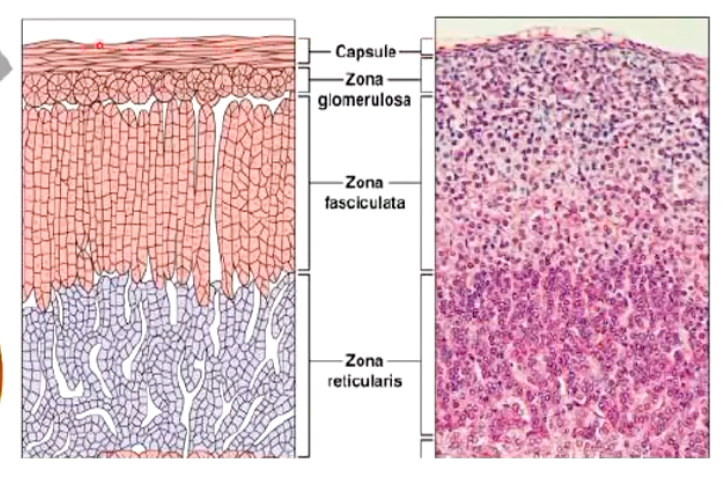
What hormones does the adrenal cortex produce?
3 steroid hormones (lipid soluble)
What is the adrenal medulla derived from?
Neuroectodermal origin. Modified sympathetic ganglion, chromaffin cells
What hormones does the adrenal medulla produce?
Catecholarmines (Water soluble)
Describe how hormones in the adrenal cortex are produced.
Note each layer.
Cholesterol precursors brought via blood → mitochondria
Converted to pregnenolone
Conversion + Uptake influenced by ACTH
Zona Glomerulosa
Mineralocorticoids
Zona Fasciculata
Glucocorticoids
Zona Reticularis
Androgens
What hormone regulates the uptake of cholesterol into the mitochondria and conversion is ____ from the ______.
ACTH, pituitary
What function do the mineralocorticoids have?
Stimulates the reabsorption of Nat from urine, saliva, gastric juices and sweat ESSENTIAL for life
Affects…
• Hypertension
• Cellular hypertrophy
• Cellular growth
• Remodeling and fibrosis
• Oxidative processes
• Decrease insulin sensitivity
• Increase Adipogenesis
What function do the glucocorticoids have?
Metabolic homeostasis, Adaptation to stress, Anti-inflammatory
Affects…
• Visceral obesity
• Increase Free Fatty Acid
• Triglycerides accumulation
• Metabolic syndrome
What function do the androgens have?
Precursors of sex steroids, Sexual differentiation, Protein anabolism
Affects…
• Polycystic Ovary Syndrome
• Hyperinsulemia
• Insulin resistance
Describe the histological features of the zona glomerulosa.
What is the primary hormone produced here?
Mineralcorticoids - Aldosterone
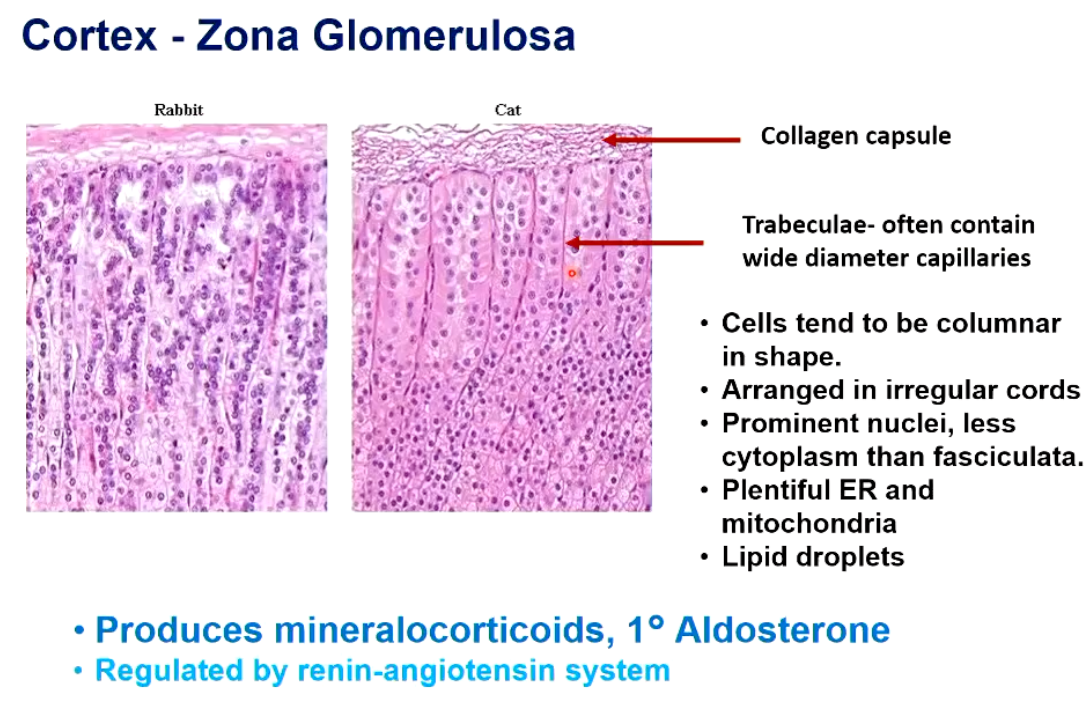
Reminder, what stimulates aldosterone secretion?
Angiotesninogen → Angiotensin I → Lungs → Angiotensin II → Adrenals → Aldosterone secretion

What effects does aldosterone have when released?

What is Conn’s Syndrome?
Describe key features and symptoms.
Hyperaldosteronism
Primary - Adrenal tumour, hypersecreting aldosterone and low renin
Secondary - Bilateral adrenal hyperplasia
Occurs in older cats, occasionally dogs
Symptoms:
Hypokalemia (1 K+ excretion)
Hypernatremia (1 plasma Nat)
Metabolic alkalosis
Leading to…
Lethargy
Cervical ventroflexion (cats)
Hypertension
Blindness
Renal failure
Muscle weakness
Describe the histological features of the Zona Fasciculata in the cortex.
What are the primary hormones produced here?
Glucocorticoids - Cortisol (Most mammals) or corticosterone (Rodents, birds)
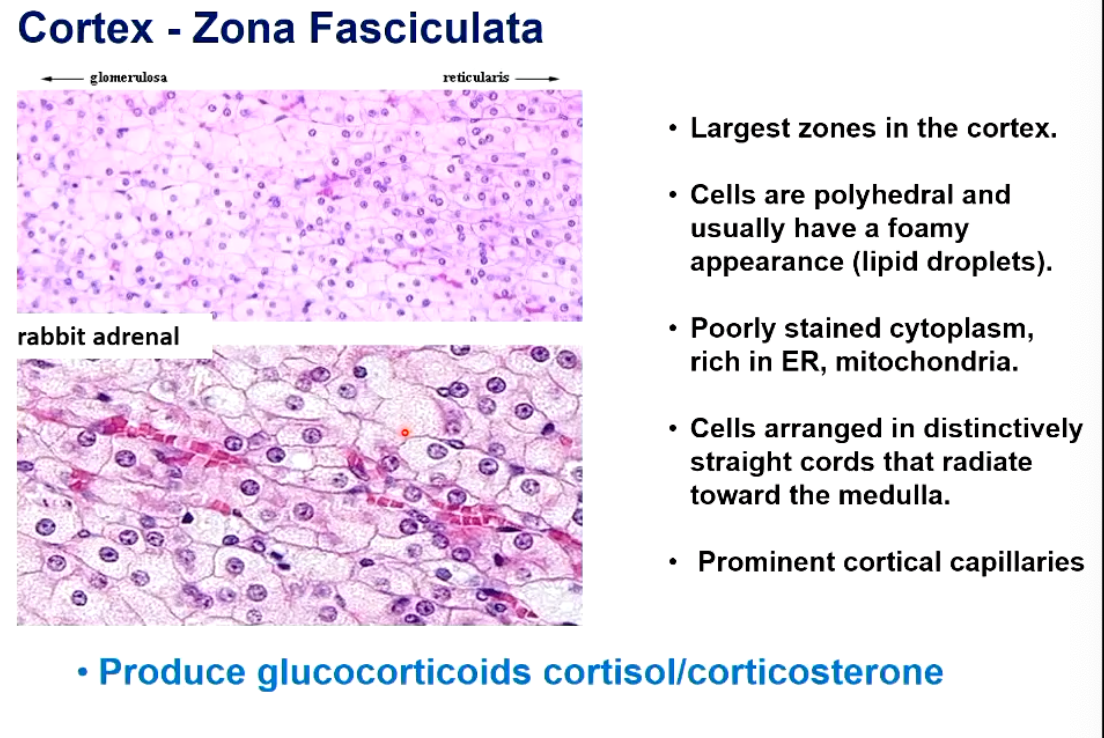
Describe how glucocorticoids are stimulates to be released.

What hormones have a central role in regulation of glucose metabolism.
Glucocorticoids
What does an increase in cortisol + corticosterone do within the body?
Ultimately mobilizing energy, allowing body to adapt to stressful situations

What is cushing’s syndrome?
Hyperadrenocorticism
3 forms:-
Adrenal tumours, secrete cortisol independently of ACTH (15% Cushings dogs: 3:1 F:M)
Pituitary hyperplasia, non-pituitary ACTH- or CRH-secreting tumours
Pituitary tumour, excess production of ACTH (85% of cushings dogs).
What are some of the symptoms of cushing’s syndrome.
Polyuria, polydipsia, Polyphagia
Lethargy
Panting (dogs)
Recurrent UTIs
Loss of muscle mass
Hair loss, (symmetrical, dogs)
Long hair, delayed shedding (horses)
Skin diseases (dogs), thin skin (cats)
Compromised reproduction
Hepatomegaly, resulting in pot belly
Sweating
Osteoporosis
Altered carbohydrate metabolism (can predispose horses to laminitis).
What is iatrogenic cushing’s?
Seen in dogs medicated for long periods of time with drugs that mimic cortisol
Changes how body reacts to normal cortisol
What is Addison’s disease?
Adrenocortical insufficiency
Inadequate Cortisol AND aldosterone secretion
Primary - defect at the adrenal gland, most common, autoimmune
Secondary - pituitary tumour, or following discontinuation of long-term steroid treatment
What are the main symptoms of Addison’s disease?
Lethargy and weakness
Poor appetite
Vomiting, diarrhoea, weight loss
Depression
Dehydration
Polydipsia polyuria
Low plasma glucose
Metabolic acidosis
Low body temp
Shaking
Weak pulse, slow heart rate (K* retention)
Increased pigmentation
Addisonian crisis, shock and collapse (dogs) - very acute sysmptoms
In ability to cope with stress
Describe histological features of the Zona Reticularis component of the cortex.
What are the primary hormones produced here?
Least active region of cortex
Androgens and glucocorticoids - regulated by hypothalamis via pituitary
Size of zone varies under different physiological conditions
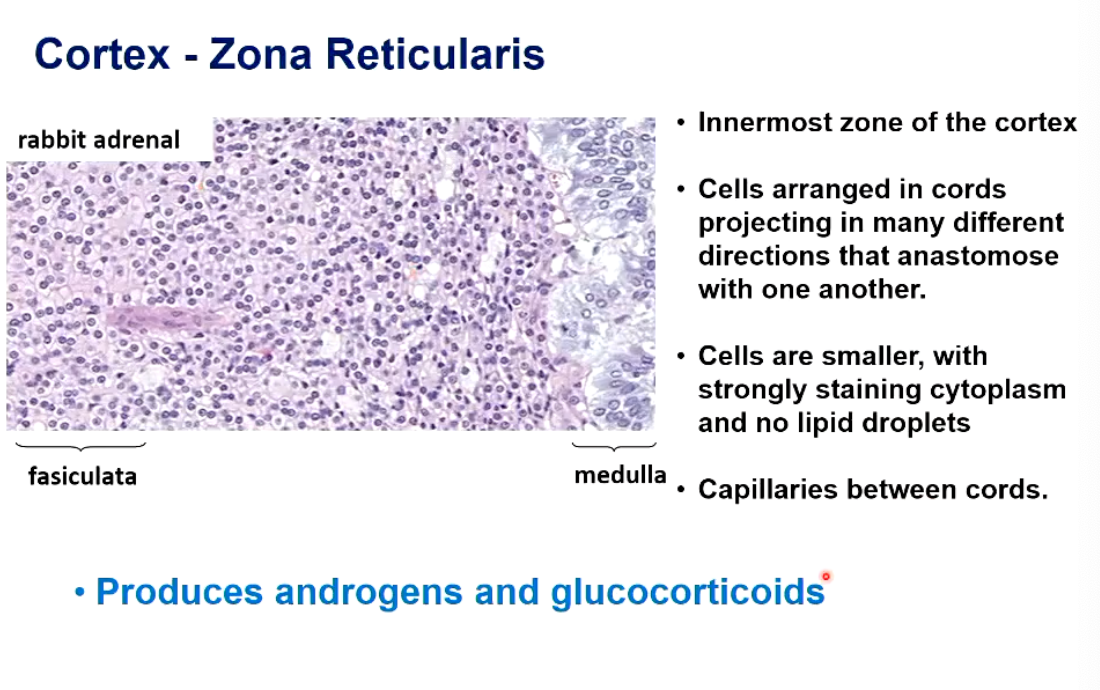
What androgens are produced in the zona reticularis?
Dehydroepiandrosterone sulphate (DHES), Dehydroepiandrosterone (DHEA) and androstenedione
What is the main regulatory factor of androgen secretion?
ACTH
What actions do the androgens have?
Lower androgenic activities relative to T.
Minor effects in intact males, only source of androgens in castrated males.
Can be converted to ostrogens typically in adipose and hepatic tissues.
Androgen production can become significant in some pathological conditions
Describe key histological features of the medulla in the adrenal gland.
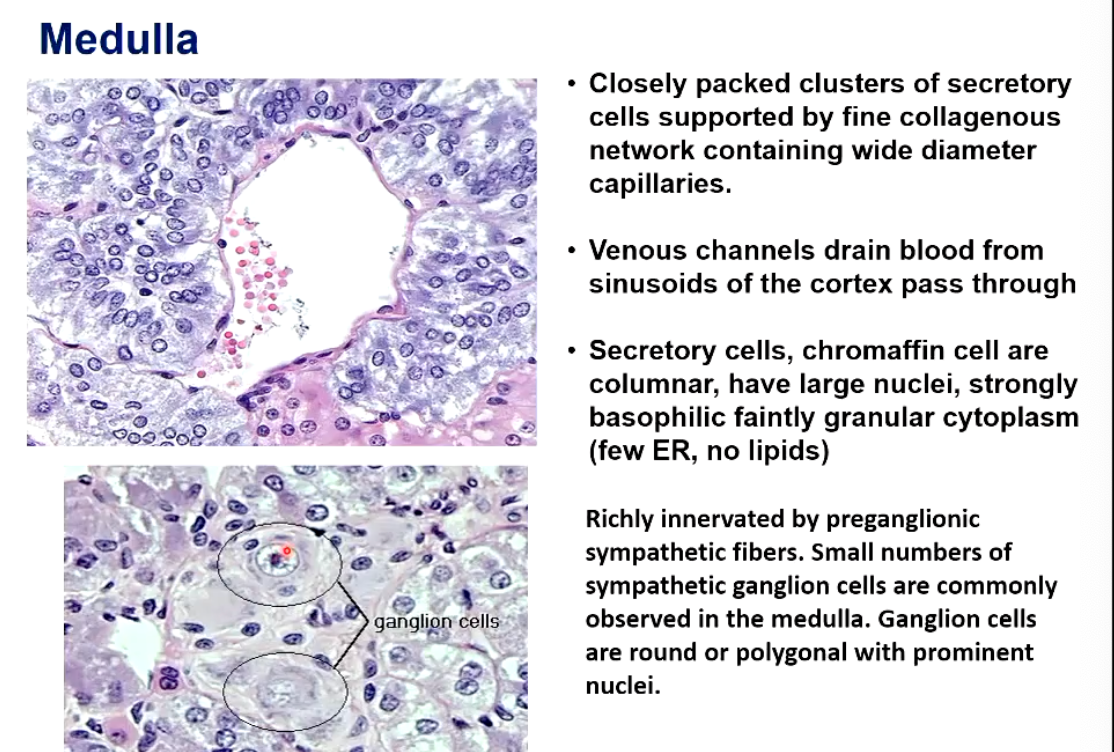
What are the main hormones produced by the medulla?
Catecholamines
Adrenaline/epinephrine, noradrenaline/norepinephrine, dopamine
Dopamine → noradrenaline → adrenaline (Conversions)
Secretion of Adrenaline (80%) > noradrenaline (20%)
How is catecholarmine secretion regulated?
Synthesised and stored within cells.
Basal release.
Some always released at a baseline level
Released stimulated by ACh release from preganagionic SNS fibres, triggering chromaffin cells to release catcholamines.
Fight or flight
What affect does the release of catcholamines have on the body?
Increase/Decrease Smooth muscle contraction (receptor dependent)
Increase Cardiovascular activity
Broncodilation
Mobilize resources…
Increase glycogen breakdown
Increase gluconeogenesis
Increase lipolysis
Liberation of energy we can use.